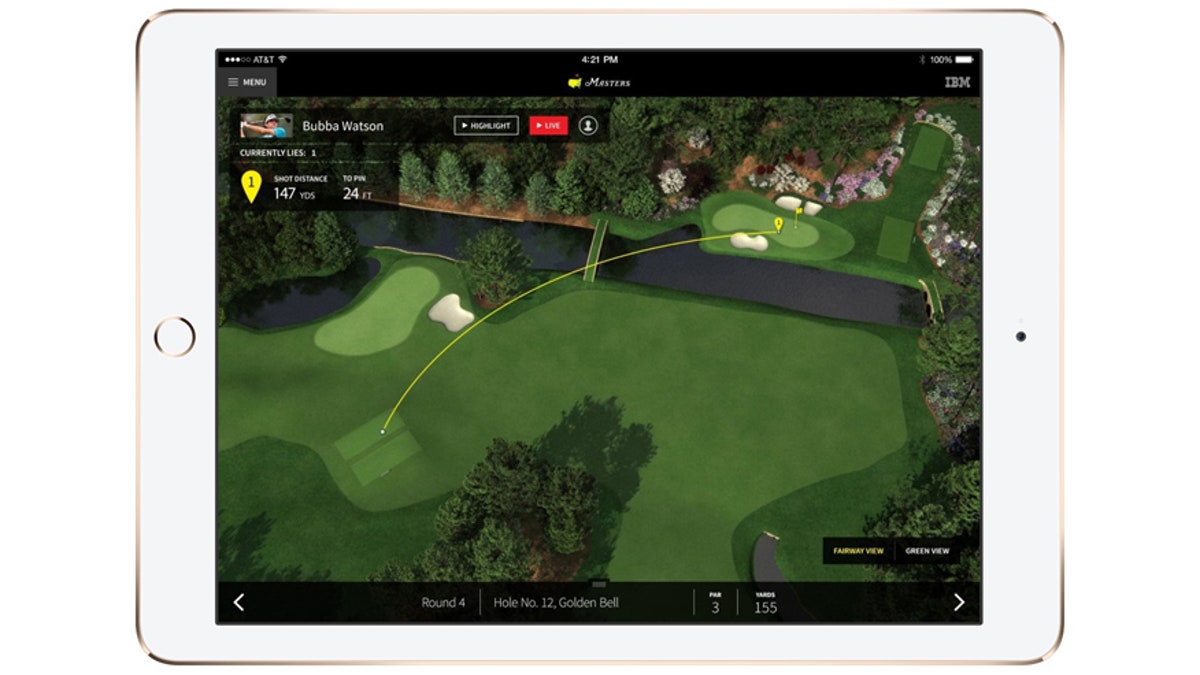
Track app green view. (IBM)
Whether watching up close and personal at the Augusta National golf course or from a laptop in Augusta, Maine, IBM is making sure that golf fans feel part of the action at the 2015 Masters Golf Tournament. Similar to its work with the U.S. Open, IBM has made the Masters into something of an international, digital sporting event, using cloud computing and visually pleasing apps to provide real-time updates over the course of the four-day tournament.
“This is a big year for us and Augusta,” IBM Technology Manager John Kent told FoxNews.com. “We’ve totally reimagined the digital experience for the Masters.”
IBM has been a sponsor of the tournament, shaping its presentation to fans since the early 1990s, Kent said. In 1996, IBM helped the tournament launch its first website. A lot has changed since then. In a social media-fueled, interconnected media age, Kent asserted that it’s crucial fans from around the world feel like they are actually there, experiencing the tournament in real time.
Since the end of last year’s tournament, IBM has been refining and overhauling everything about the Masters’ digital presence — from the aesthetic presentation of the website to developing easy-to-use mobile apps. The big feature this year is Track, which is a real-time visualization of where the ball is traveling at each hole of the course.

Track app fairway view. (IBM)
“We’re taking advantage of all the tracking data of all 18 holes in the Masters — it takes you immediately to whoever is the leader of the course, see how the drive was, etcetera,” Kent said. “You can see how the player is progressing and follow that player in real-time as a second screen experience.”
Track can be accessed on any mobile device or computer. With its simple, computer-animated recreation of the course — every detail is captured, including shadows cast by nearby trees — Track provides golf fans with access that they might not necessarily get from just watching their TVs or following updates on Twitter. IBM captures this data using lasers that are situated across the course. IBM uses cloud computing to gather the data sent up to them from the lasers and then can visualize that information.
In designing Track and the various web and mobile properties associated with the Masters, Kent said that it was important that his team keep in mind that they were “telling the story of the Masters.”
While the visual mapping of the course is key to Track, IBM users can find golf statistics, player information, and schedule and tournament information all by accessing a menu drop-down that is at the top right corner of the page. Kent said that the main idea was to keep the Track app as clean-looking as possible. There is no clunky leaderboard crowding the digital course map, but a link to it is still there for users who want their traditional golf stats. There is also video content, from video feeds of the course to simulcasts from CBS and ESPN.
What about planning for next year? Kent said it’s “already a work in progress.”
“You can always strive to do better, good is not good enough,” Kent said. “You are always thinking about ‘when will 4K-resolution video be available? What technology will be around down the line that we can embrace?’ ”
All of IBM’s Masters apps have a “feedback mechanism” and the company takes those complaints and suggestions from users to make improvements going forward, Kent added.
“The Masters and IBM share a lot in common. Innovation is extremely important and the Masters really wants to be the leader in the world of digital, and we feel that is achieved this year with this reimagined experience,” Kent said. “They are willing to take that risk, push forward, and set a new standard with us. It’s a great mix of two great organizations.”
